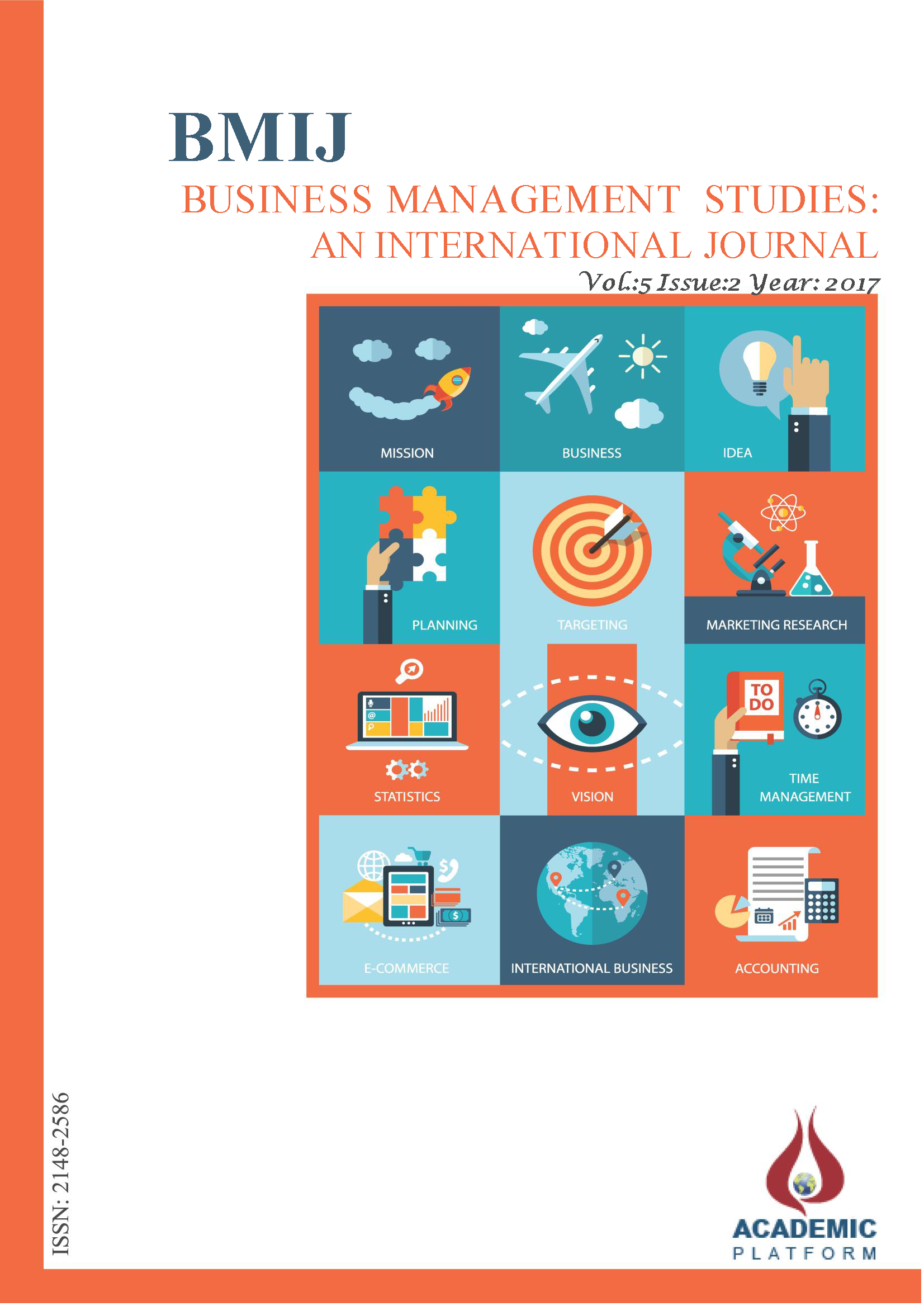Makaleler
HASTANE HİZMET KALİTESİNİN HASTA AİDİYETİ ÜZERİNE ETKİLERİ: YAPISAL EŞİTLİK MODELİ VE ARABULUCULUK

Yayınlanmış 2017-09-16
Anahtar Kelimeler
- Hizmet Kalitesi,
- SERVQUAL,
- Yapısal Eşitlik Modeli,
- Hastane,
- Arabuluculuk
Nasıl Atıf Yapılır
FİRUZAN, A. R. (2017). HASTANE HİZMET KALİTESİNİN HASTA AİDİYETİ ÜZERİNE ETKİLERİ: YAPISAL EŞİTLİK MODELİ VE ARABULUCULUK. Business & Management Studies: An International Journal, 5(2), 462–480. https://doi.org/10.15295/bmij.v5i2.129
Özet
Bu çalışmanın amacı, hastaneden beklenen ve algılanan hizmet kalitesi düzeylerinin hastane aidiyetleri üzerindeki etkilerini ölçmektir. Toplamda 370 hasta araştırmaya dahil edilmiştir. Nedensel ilişki modelini test etmek için Yapısal Eşitlik Modelleme (YEM) yöntemi kullanılmıştır. Çalışmada ele alınan model, kabul edilebilir düzeyde uyumlu bir model olarak çıkmıştır. Hasta aidiyeti ile algılanan hizmet kalitesi arasında pozitif yönlü, istatistiksel olarak anlamlı bir ilişki çıkmıştır. Ayrıca, algılanan hizmet kalitesi, hasta aidiyeti ile beklenen hizmet kalitesi arasında arabuluculuk etkisine sahiptir. İlgili hastanede hastalar tedavi gördükten sonra algıladıkları hizmet kalitesinden etkilendikleri kadar tedavinin maliyetinden de etkilenmektedirler. Memnuniyetleri arttıkça aidiyetleri de artmaktadır. Hastane yönetimine, hasta aidiyetini arttırmaları için güvenilirlik ve güven SERVQUAL boyutlarını iyileştirici yönde faaliyet göstermeleri önerilmiştir.İndirmeler
İndirme verileri henüz mevcut değil.
Referanslar
- Babakus, E ve Mangold GW (1992)“Adapting the SERVQUAL scale to hospital services: an empirical investigation”, Health Service Research, 26 (6), 767-786
- Bagozzi RP ve Yi Y (1988) “On the evaluation of Structural Equation Model” Journal of the academy of marketing science 16 (1), 74-94
- Berhane, A ve Enquselassie F (2016) “Patient expectations and their satisfaction in the context of public hospitals” Patient Prefer Adherence, 10, 1919-1928
- Byrne BM (2010) Structural Equation Modeling with AMOS Basic Concepts, Applications, and Programming. Taylor and Francis
- Cohen J (1988) Statistical power analysis fort he behavioral sciences, 2.Baskı, Hillsdale NJ
- Dawn AG, Lee PP (2004) “Patient expectations for medical and surgical care: a review of the literature and applications to ophthalmology.” SurvOphthalmol, 49, 513-524
- Erdem İ, Yeloğlu HO (2007) Zaman Serisi Verilerine Bootstraping Metodu Uygulaması. 6. İstatistik Kongresi: Antalya
- Field, (2000) Discovering Statistics using SPSS for Windows. London, Thousand Oaks, Sage Publications, New Delhi.
- Fornell CG ve Larcker DF (1981) “Evaluating structural equation models with unobservable variables and measurement error” Journal of Marketing Research, 18 (1), 39-50
- Hair JF, Tatham RL, Anderson RE ve Black W (2010) Multivariate Data Analysis. 5.Baskı, Prentice Hall, Englewood Cliffs, NJ, USA.
- Henseler J, Ringle CM ve Sinkovics RR (2009) “The use of partial least squares path modeling in international marketing”, New Challenges to International Marketing (Advances in International Marketing, Volume 20) Emerald Group Publishing Limited, 277 – 319.
- Hu, LT ve Bentler, PM (1998). “Fit indices in covariance structure modeling: Sensitivity to under parameterized model misspecification” Psychological Methods, 3(4), 424-453.
- Hu, LT ve Bentler, PM (1999). “Cutoff criteria for fit indexes in covariance structure analysis: Conventional criteria versus new alternatives” Structural Equation Modeling: A Multidisciplinary Journal, 6(1), 1-55.
- Jiang, JJ, Klein G, Parolia N ve Li Y (2012). “An analysis of three SERVQUAL variations in measuring information system service quality” Electronic Journal Information Systems Evaluation, 15 (2)
- Kim CE, Joon-Shik S, Jinho L, Yoon Jae L, Me-riong K, Areum C, Ki Byung P, Ho-Joo L ve In-Hyuk H (2017), “Quality of medical service, patient satisfaction and loyalty with a focus on interpersonal-based medical service encounters and treatment effectiveness: a cross-sectional multicenter study of complementary and alternative medicine (CAM) hospitals”, BMC Complementary and Alternative Medicine, 17, 174-186
- Lim PC, Tang NKH (2000a) “A study of patients' expectations and satisfaction in Singapore hospitals. Int J Health Care Qual Assur. 13, 290-299
- Lim, PC ve Tang NKH (2000b), “Modifiedimportance-performanceanalysis: an applicationtohospitals”, International Journal of HealthCareQualityAssurance, 14 (3), 104-110
- Lim, PC ve Tang NKH (2000c), “Thedevelopment of a model for total qualityhealthcare”, Managing Service Quality, 10 (2), 103-111
- Litwin MS (1995) How to Measure Survey Reliability and Validity. Thousand Oaks, Calif, USA: Sage
- Lohmöller, JB (1989) Latent variable path modeling with partial least squares. Heidelberg: Physica
- Memon AH ve Rahman A (2014) “SEM-PLS Analysis of Inhibiting Factors of Cost Performance for Large Construction Projects in Malaysia: Perspective of Clients and Consultants” Scientific WorldJournal, Article ID 165158, 9 pages http://dx.doi.org/10.1155/2014/165158
- Rahman, S, Erdem, R. ve Devebakan, N. (2007). “Hizmet kalitesinin SERVQUAL ölçeği ile değerlendirilmesi: Elazığ‟daki hastaneler üzerinde bir çalışma” Dokuz Eylül Üniversitesi Sosyal Bilimler Enstitüsü Dergisi, 9, 37-55.
- Şimşek ÖF (2007) Yapısal eşitlik modellemesine Giriş, Temel İlkeler ve LISREL Uygulamaları, Ankara
- T.C. Kuzey Anadolu Kalkınma Ajansı (KUZKA), Özel Hastane Ön Fizibilite Raporu (2016), https://www.kuzka.gov.tr/paylasim/01_ozel_hastane_(on_fizibilite).pdf
- Venkatraman, N (1989) “The concept of Fit in Strategy Research: Toward Verbal and Statistical Correspondence”, Academy of Management, 14 (3), 423-444
- Virk, A, Kalia M, Gupta BP, Singh J (2013) “A study to evaluate patient expectation and satisfaction in tertiary care teaching hospital” Healthline, 4 (2), 64-68
- Wong, K.K (2013). Partial Least Squares Structural Equation Modeling (PLS-SEM) Techniques Using SmartPLS. Marketing Bulletin, 24, Technical Note 1, 1-32.
- Zeithaml VA, Berry LL ve Parasuraman A (1996) “The behavioral consequences of service quality” J Marketing, 60, 31-46.

